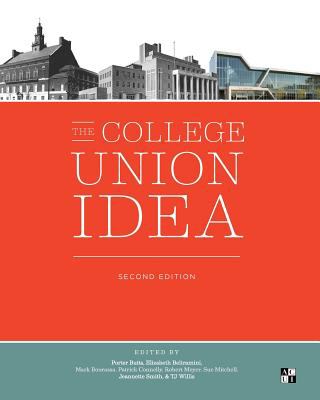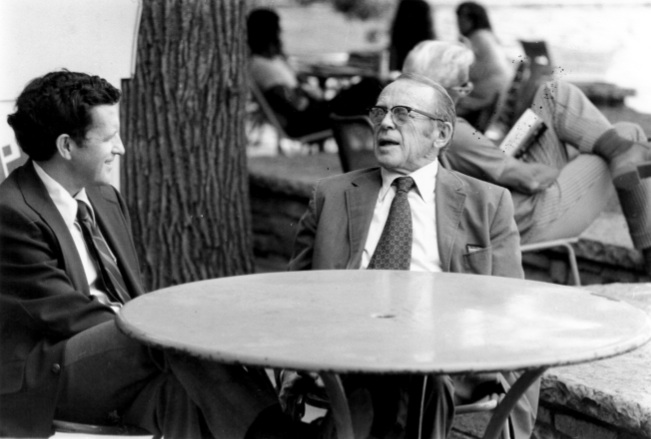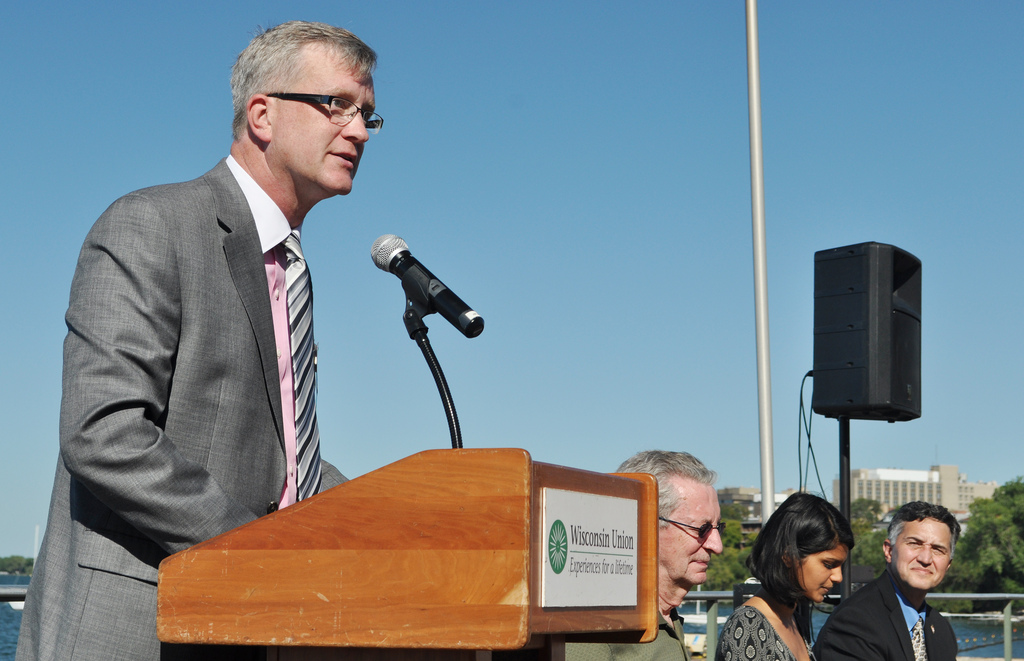Porter Butts and his ‘Union Idea’
By Brooke Appe
In a statement adopted by the members of the Association of College Unions at its 33rd Conference in 1956, Porter Butts wrote “the Union is the community center of the college, for all the members of the college family—students, faculty, administration, alumni, and guests. It is not just a building: it is also an organization and a program. Together they represent a well-considered plan for the community life of the college.”
One visit to either of the incredible Unions on the UW-Madison campus undoubtedly proves that Porter’s strong vision continues to thrive. Though the physical structures that symbolize the Union’s enduring presence on campus have somewhat changed along the way (and are undergoing transformations right now as part of the Memorial Union Reinvestment), the goal of the Wisconsin Union has remained the same since Memorial Union first opened in 1928: to bring people together as “a unifying force in the life of the college,” as Porter described.
Today, college unions are seen all over the country as a place for the campus community to unite through programming and activities – but it was Porter Butts who was instrumental in pioneering this movement. Considered the grandfather of the college union movement in the United States, Porter was a driving force in encouraging the foundation of college unions as an integral part of campus life. “The word union means coming together and that was Porter’s basic philosophy. That’s the bottom line,” said Ted Crabb, who was Director of the Wisconsin Union from 1968 to 2001. He worked closely with Porter Butts at the Union during his time as a student from 1953 to 1954 and then as a staff member from 1954 to 1964.
Porter is not only remembered by his legacy at UW-Madison as the Director of the Wisconsin Union from 1926 to 1968, but his spanning influence on campuses throughout the country and world. He was instrumental in shaping the Association of College Unions International (ACUI), serving as the president of the Association in 1932, and as member of the executive committee and editor of Association publications from 1936 to 1970.
Bringing the campus community together was the backbone of Porter’s vision for the Wisconsin Union, yet that statement barely brushes the surface of what makes a union an indispensable resource on any campus. One of Porter’s main tenets stressed that invaluable university experiences happen outside the classroom, saying that it assisted in developing “students as persons as well as intellects.”
“Students who are active in the Union more fully discover who they are because they get to learn things they simply can’t learn inside the classroom,” said current Wisconsin Union Director and President-elect of ACUI, Mark Guthier. “There may be a chemistry major who has a love of the arts. They can fully develop that part of themselves. The Wisconsin Union is a true partner with the classroom in that it creates well-rounded graduates.”
Porter also heavily valued the importance of student leadership. The Union Council, the governing body for the Wisconsin Union, is based on a shared governance model that dates back to 1927. The Council is comprised of nine students and six non-student members and illustrates Porter’s “for the students, by the students” philosophy. According to Porter, a union should be “a laboratory of citizenship, training students in social responsibility and for leadership in our democracy.”
“In this particular union, there is a strong belief in strong student governance. The Union Council includes student, faculty, staff, and alumni, but the majority voice is in the hand of students,” said Mark. “We never forget that they are our largest constituency and they will always be the majority voice in discovering what the Wisconsin Union is all about – that foundation comes from Porter.”
Clearly, Porter’s ideals have carried forth from their inception many years ago through different generations of students, Union members and directors. Nevertheless, adapting to changing times can be challenging. When Porter retired in 1968, the campus was smaller with a total enrollment of around 31,000 students. Now, the campus has 42,000 students and does not seem to be slowing down. “The campus is more spread out and it’s getting harder for the Union to be the center of the campus community. Is it possible to achieve community on a campus of 42,000 plus? We try to,” said Ted.

The College Union Idea is a book put together by Porter Butts detailing the history, significance and philosophy behind college unions. The book includes writings by Porter himself and others.
As current Wisconsin Union Director, Mark works hard to evolve with the changing times while still maintaining Porter’s original philosophies. With the recent completion of a new Union South and the Memorial Union Reinvestment, the Union is taking necessary steps to ensure there is enough space and resources for students to implement their programming.
“The building project is not because we just like to build buildings – at its core is that we want to make sure we have a place for student creativity and production – to bring people together, produce events and gather people together in a comfortable way,” said Mark.
Though both Ted and Mark’s experiences as Union directors are different, they run in the same vein of Porter’s philosophy. Neither of them can deny how Porter’s distinct leadership sets the Wisconsin Union apart.
And indeed his vision has come true. “We’re a place for students, faculty, staff, alumni and Union members and we’re unique in that regard. I can’t think of another place on campus where that is true 365 days of the year,” said Mark.
Purchase The College Union Idea by Porter Butts.



